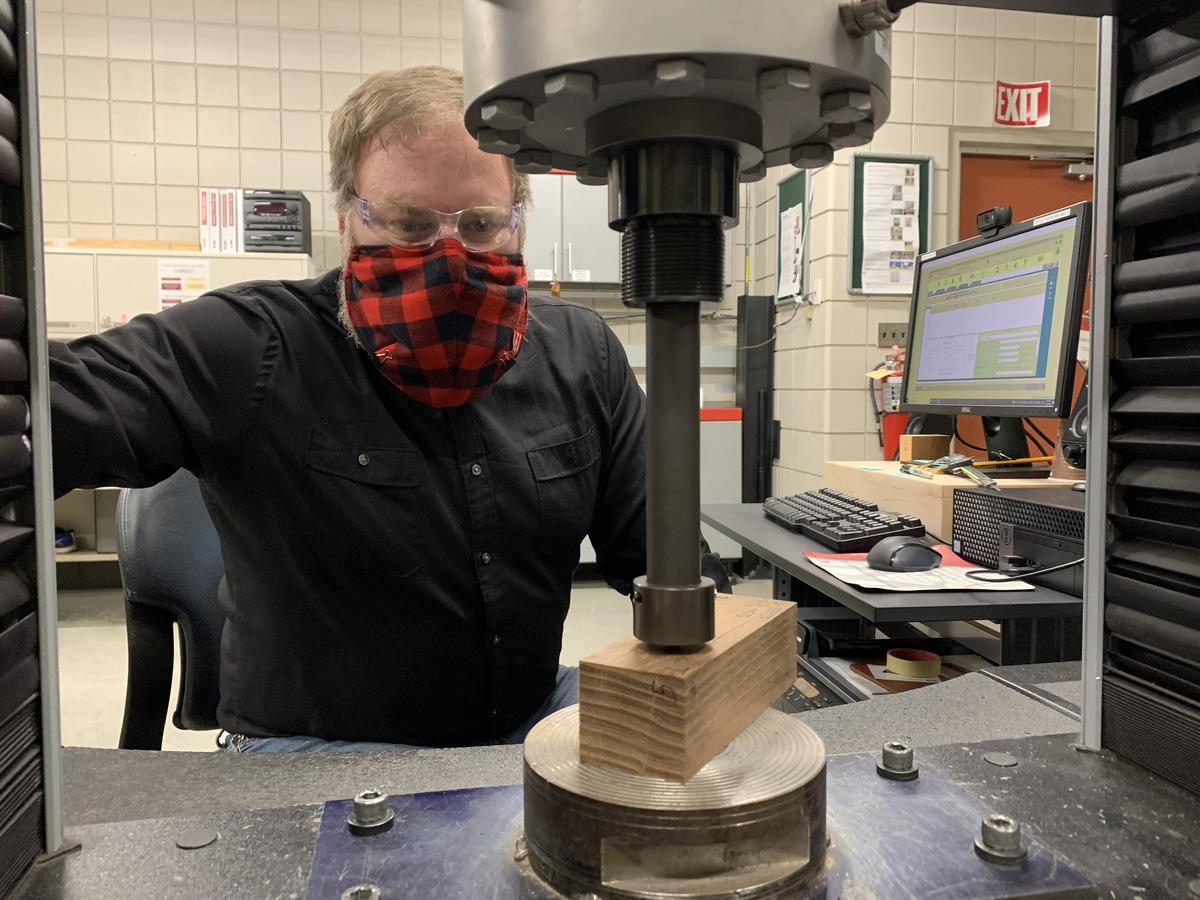With demand for construction materials up, it’s a good time to bring a (relatively) new product to the market.
Thermally modified wood is gaining market share in the U.S. as a chemical-free alternative to treated wood materials for outdoor applications, and domestic alternative to tropical woods.
“People are seeking out more sustainable products and they’re willing to pay more to get it,” said Patrick Donahue, NRRI research program manager. “The market is growing organically because of increased demand in the construction arena, but also awareness of environmental impact.”

Donahue has spent much of his 34-year career at NRRI focused on expanding markets for wood products. And some 20 years of that has been spent introducing a material to North American markets that’s at once new… and old. Thermally modified wood is heat-treated in a low oxygen kiln to enhance water and rot resistance and dimensional stability. And back in 800 B.C. Norway, a version of this process kept fence posts from rotting by burning the surface of the wood.
Today, Donahue points with pride to a growing thermally modified timber industry in the U.S. and – even better – here in Minnesota. Rapidly growing manufacturer Arbor Wood Co. is the latest to join the trend with a plant opening this year in Grand Rapids, Minn.
“The big shift to getting it to markets, is that two to three years ago major distribution got behind it,” said Donahue. “So it’s easier for people to get access to it.”
First steps
NRRI’s journey with thermally modified wood started in 2001 with a referral from the Minnesota Department of Employment and Economic Development that led to Donahue’s introduction to Finland’s industrial-scaled thermally modified wood industry. By 2003, Finnish industry leaders came to NRRI to discuss collaborations. The result was a contract with a global wood products manufacturer to provide an assessment on testing from the Industrial Code Council National Evaluation Report, which verifies that new building products comply with code requirements.

Matt Aro, forest products scientist, joined Donahue’s team in 2003 and the two went full-in on researching the potential of thermally modified wood.
“When I first learned about this process, I thought this is great. It’s chemical-free, it’s environmentally friendly. It’s beautiful,” said Aro. “Why do so few people know about it?”
Still leaning on their contacts in Finland, they gleaned what insights they could about what it would take to get U.S. manufacturers onboard. A USDA grant funded the transport of Minnesota basswood, red pine and yellow poplar – all low-value, underutilized trees species – to Finland for custom modification, then back to NRRI for testing.
Growing interest
By 2011, the first North American Thermally Modified Timber Conference was held in West Virginia and NRRI found another key collaborator. Mathew Leitch from Lakehead University in Thunder Bay, Ontario, helped the team spearhead the effort to get the data needed to publish a guidance document for listing thermally modified wood in the American Wood Protection Association 2014 Book of Standards.
But to really make an impact in building interest in thermally modified wood, NRRI needed its own capability to thermally modify wood in pilot quantities for testing. In 2012, a specially designed pilot-scale thermal modification kiln was installed at NRRI in partnership with the Northwest Regional Planning Commission with funding from the Wisconsin Business Innovation Corp. This unique kiln was designed in the Netherlands, built in Spain and shipped to NRRI.
Research and testing take off
Then, the new kiln was put to work. Aro received National Science Foundation funding to test a variety of engineered wood products – bending strength and stiffness, water absorption, screw-holding capability, hardness, and other properties with a prominent U.S.-based engineered wood products manufacturer.
Working in NRRI’s Materials Testing Lab, researchers Victor Krause and Scott Johnson have provided invaluable capabilities that help clients understand the performance of their materials and help move thermally modified wood products to market. They were able to slightly modify how the materials are machined, conditioned and tested to fit the uniqueness of thermally modified wood.
“Just having easy access to that kind of service has been really helpful to industry,” said Aro. “Wood is complex, and each species has its own characteristics. Each wood species responds differently to thermal modification, so it’s important to understand how the modification process affects physical and mechanical properties of the wood.
In the years that followed, many U.S. Forest Service Wood Innovation grants have allowed Donahue and Aro to expand their focus from thermally modified wood for the window and door industry to siding, decking and other construction opportunities.
A recent National Science Foundation-funded partnership led by Washington State University has Aro and team investigating the potential of thermally modified strand-based mass timber panels made from small diameter ponderosa pine and lodgepole pine – two fire hazard species in the Pacific Northwest. The team is hoping for additional funding to test the same process with Minnesota’s small diameter balsam fir.
Minnesota grown
And now, as Arbor Wood Co. gears up to modify wood in the repurposed Ainsworth Lumber mill and expand the market for this material, Kelly Bartz, Arbor Wood Co. chief operations officer, is looking forward to continued research opportunities with NRRI.
“NRRI has been able to help us obtain the required mechanical properties and accelerated aging tests for our raw and finished goods,” said Bartz. “And we’ll use their capabilities to explore and vet new wood species to bring to market. Preferably species domestic to Minnesota.”
Arbor Wood Co. has more than $10 million worth of pending contracts ranging from retail to hotels to national park projects. High-end designers and industry influencers are also showing interest in using and promoting thermally modified wood.
“We did a lot of pivotal things at NRRI and, frankly, we took a risk,” said Donahue. “Faced with change, the wood industry moves very, very slowly. But seeing this take off and seeing the potential is very satisfying to me, personally and professionally.”
PHOTO: NRRI Wood Scientist Victor Krause tests thermally modified wood samples in the Mechanical Test Lab in February.
Associated Staff
